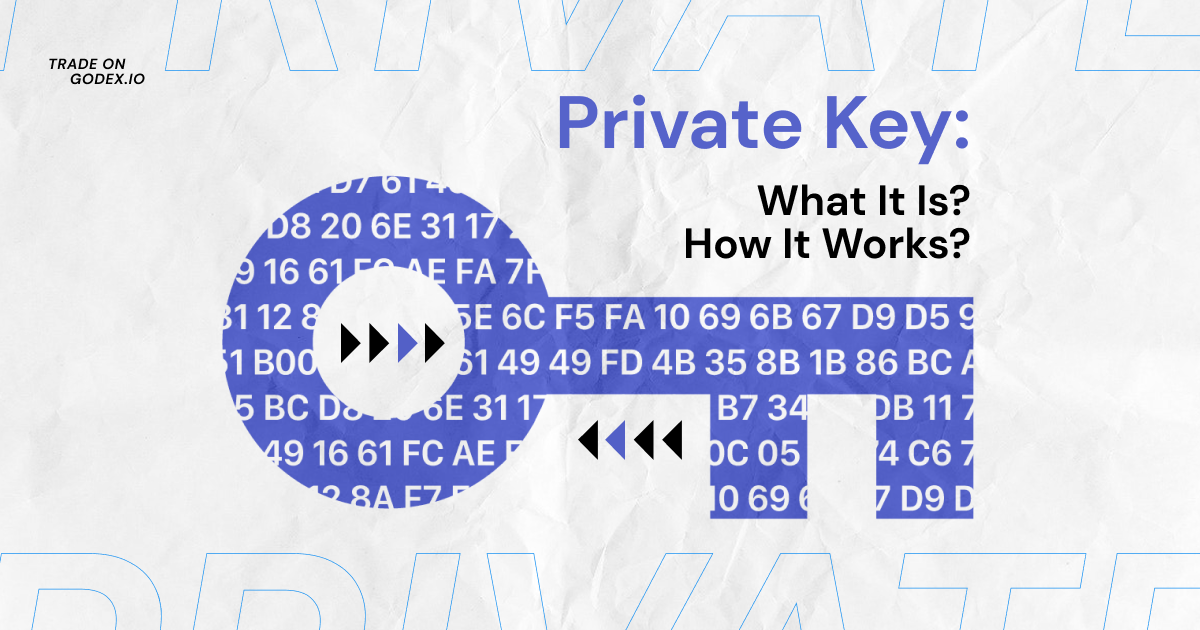Table of Contents
At the core of every blockchain account lies the crucial private key, which is essential for conducting even the most basic transactions. To put it simply, when individuals claim they have ownership of certain cryptocurrencies, in essence, they possess the private key to the corresponding wallet where those digital assets are secured. It’s important to note that cryptocurrencies are never actually housed within a wallet; they remain on the blockchain itself. What you do control is the unique code that grants you access to those assets.
So, what is a private key? How it operates and how to store it? Let’s find out in this piece.
What is a Private Key?
This private key is paramount as it confers the privilege to its holder to transfer or spend the associated digital currencies. If this key were to fall into the wrong hands, that individual would then have the capability to access and control your account, which is why it must be kept confidential. Your account is safeguarded by a singular private key, akin to a secret passphrase that only you should be privy to.
The role of private keys extends beyond simply guarding access to your funds; they are the foundational element that dictates the operation of your crypto wallet and your interactions with other blockchain accounts. In essence, your private key is responsible for producing your public key. Its functionality isn’t limited to generating just one public key — it can create several. This isn’t a mere flourish; generating multiple keys is integral to maintaining the link between these keys through a cryptographic process known as a trapdoor function.
Role of Private Keys in Encryption
Private key encryption is a subject that appeared before digital currencies. The principles of public and private key pairs are rooted in a field known as Public Key Cryptography (PKC), also known as Asymmetric Encryption.
These key pairs serve two primary purposes: encryption and signing. Encryption is utilized to secure confidential data, ensuring that only the designated receiver can decrypt and read the information. Signing, conversely, is employed to confirm the legitimacy of a transaction, ensuring that it has not been altered or counterfeited. While encrypting with a public key plays a significant role in various security domains, this technique is only sometimes applied within standard public blockchain environments. In these networks, the pivotal application of these keys is for the signing process.
How Does a Private Key Work?
What is private key and how it functions? Cryptocurrencies operate on a system where digital keys signify asset ownership and control. To move cryptocurrencies like Bitcoin, one simply needs a public address, but accessing or using them requires a unique and secure private key. These keys, often too lengthy to be practical in raw numeric form, are condensed into a more manageable string of characters.
A cryptographic algorithm generates a public key from a private one, ensuring the process’s security. Conversely, deducing the private key from its public equivalent is near impossible. This public key then forms a digital address, comparable to a secure mailbox, which can only be accessed by the corresponding private key.
As letters can be dropped into a mailbox by anyone, cryptocurrencies can be sent to any public address, but only the holder of the right private key can unlock and retrieve the assets. This is why securing one’s private key is critical—as its loss or theft could lead to unauthorized access to one’s digital funds.
What Do Private Keys Look Like?
What is a private key cryptographically? How does it look? A blockchain private key is essentially a complex numerical value, consisting of a long string of digits for security purposes. To make it manageable, this number is typically encoded as a series of alphanumeric symbols. Bitcoin and Ethereum, for example, utilize a cryptographic method known as the Elliptic Curve Digital Signature Algorithm to produce their respective private and public keys.
To understand the appearance of private keys across various blockchains, let’s examine some examples:
On the Ethereum platform, the private key consists of a 64-character string in hexadecimal format.
For instance: b1a2bc2efg58h901j456klm78np901qr234st5uv67wx8y9z01234a5b6c7d8e9f.
In the case of Bitcoin, the system employs a 256-bit number, which can be expressed in multiple forms.
For example, A1B2C3D4E5F60708G9H0I1J2K3L4M5N6O7P8Q9R0S1T2U3V4W5X6Y7Z8Z9A0B1C2D3.
Regardless of the blockchain, the rule of thumb with private keys is absolute confidentiality: never store them digitally where they might be accessed by others. Your private key is the linchpin to your digital assets, and it should remain invisible to all but yourself.
Securing Private Key Storage
Cryptocurrencies rely on digital keys for ownership and transaction control; a public address allows for sending funds, but a private key is crucial for access and use. These private keys, usually lengthy numerical sequences, are simplified into alphanumeric strings for practicality. Through cryptographic algorithms, a public key is generated from a private key, forming a digital address that functions much like a lockable mailbox, accessible only by the matching private key. The integrity of cryptocurrency management thus hinges on the safeguarding of the private key, as its compromise or misplacement could permit unwanted access to the crypto assets.
After learning about what is private key encryption and how to store it, let’s be equipped with potential pitfalls when using private keys.
Potential Threats to Private Keys
The security of your cryptocurrency is intrinsically linked to the protection of your private key. The approach you take in handling this key is paramount for the safeguarding of your digital assets. There are several critical aspects to ponder in this context.
Initially, one must question whether they truly possess their private keys.
Custodianship
Using a centralized crypto exchange means you entrust your private keys—and thus control of your assets—to that platform. While these exchanges implement robust security, they ultimately limit your control, as the maxim “Not your keys, not your coins” implies true ownership is tied to key possession.
Opting for a non-custodial wallet, however, grants you self-custody, placing the power of true ownership in your hands. Such wallets give you control over your private keys and, consequently, your cryptocurrency. Yet, owning your private keys isn’t without risks, as self-custody also exposes you to potential security threats.
Cyber Threats
One of the foremost dangers to your wallet’s security is the risk of online hacking.
Wallets running on internet-connected devices such as smartphones or computers offer convenience but pose a risk by storing private keys locally. If a hacker accesses such a device, they could steal your private keys, and with them, the authority to control your associated assets. Hence, the holder of the private keys has full command over the linked cryptocurrency.
FAQ
How is a Private Key generated?
A private key is generated through a random number generation process that ensures a high level of unpredictability, utilizing cryptographic algorithms for security. This sequence is then encoded into a digestible format, like a string of alphanumeric characters, for use within a cryptographic system.
Can a Private Key be changed or reset?
Once a private key is created for a cryptocurrency wallet, it cannot be altered or reset; it is a permanent and unique identifier for that wallet. If security is compromised, the solution is to create a new wallet with a new private key and transfer the funds to it. We also highly recommend a few sources about what is a private key in crypto and how to use it efficiently.
Start a Cryptocurrency exchange
Try our crypto exchange platform
Disclaimer: Please keep in mind that the content of this article is not financial or investing advice. The information provided is the author’s opinion only and should not be considered as direct recommendations for trading or investment. Any article reader or website visitor should consider multiple viewpoints and become familiar with all local regulations before cryptocurrency investment. We do not make any warranties about reliability and accuracy of this information.
 Peter Moore
Peter Moore 
Read more
Ripple (XRP) price has been widely discussed by the cryptocurrency community since it has gained public interest in 2017, even though it was founded by Chris Larsen and Jed McCaleb years before. The platform offers innovative blockchain solutions for the banking sector and has the potential to disrupt the whole finance industry. In recent years, […]
In this article we will talk about Ripple (XRP) and its price prediction. What is Ripple (XRP) Ripple is a San Francisco-based startup that was launched in 2012 by Ripple Labs as a global network both for cross-currency and gross payments. Ripple history began in 2004 with the discussions around the digital coin in the […]
You may well think that an article dedicated to a Tether price prediction or the Tether price in general is a little bit strange — it is a stablecoin after all. However, the price of Tether does fluctuate significantly, although it is nowhere near as volatile as non-stablecoin cryptos. This means that staying up to […]
In the article we share our vision at Zcash cryptocurrency main features and add several price predictions. As cryptocurrencies gain global acceptance and decentralisation slowly enters our lives, privacy becomes the main concern when talking about blockchain adoption. It is no secret that distributed ledger is by far the most secure and transparent technology ever […]
Chiliz coin (CHZ) offers a compelling opportunity for traders interested in the intersection of blockchain technology and sports. By enabling fans to influence team decisions through the Socios app, Chiliz directly monetizes fan engagement and connects with major sports teams like Juventus and Paris Saint-Germain. These partnerships not only enhance the platform’s visibility but also […]
The exponential growth of Bitcoin Satoshi Vision (BSV) against the general bear trend on the cryptocurrency market in autumn 2019 has impressed the community. Due to the increasing market capitalization, the newly emerged altcoin was ranked 5th on CoinMarketCap and managed to maintain its high position at the beginning of 2020. In the article we […]